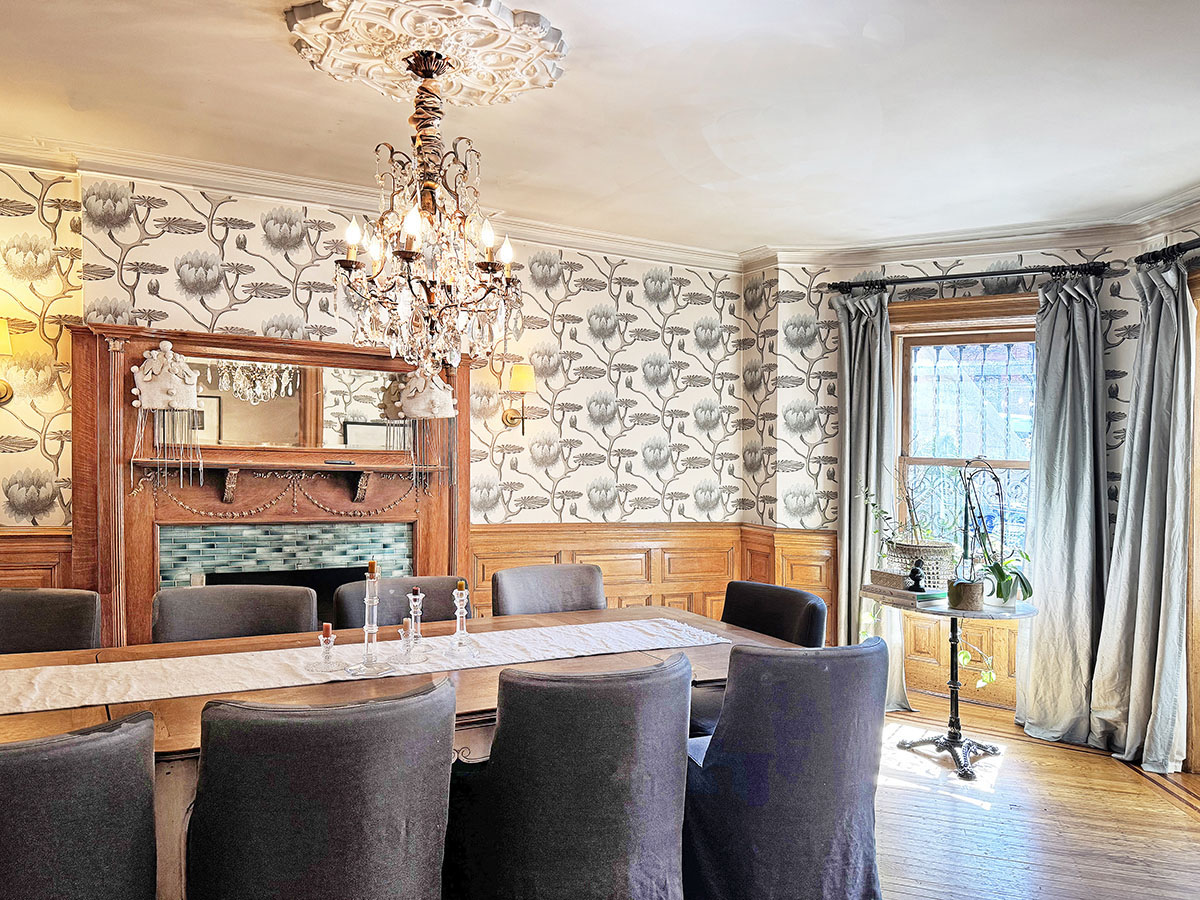Weekend Warrior: DIY Wine Cellar
We got this email on Sunday night from a reader in Clinton Hill: We wrapped up a fun and easy and cheap project today that might be of interest to wine geeks—setting up that little front basement room as a wine cellar. The husband re-attached the original door to this little storage room in the…



We got this email on Sunday night from a reader in Clinton Hill:
We wrapped up a fun and easy and cheap project today that might be of interest to wine geeks—setting up that little front basement room as a wine cellar. The husband re-attached the original door to this little storage room in the front of the building, which is good because that room has a nice, cool exterior wall (door was sitting in rear of basement) and slapped some insulation on the back of it. Ideal long-term wine storage temp is 55 degrees, and our boiler makes the cellar pretty toasty. So far it’s working great, at least in winter. We’re steady at 58-59 degrees, which is fantastic. Need to figure out the humidity—we have a gauge on back order.
Racks are mail-order from wineracksamerica.com —reasonable prices, really easy assembly, and tons of capacity. In a room that’s about 6-by-8, we can handle about 450 bottles now, and could add more racks if we wanted to. As you can see, we have a ways to go just filling up the racks we have. But today’s piece-de-resistance: The chandelier (photo on the jump), formerly hanging (ridiculously) in the front parlor of the house. Way too small, too junky-crappy for a parlor, but delightfully piss-elegant for a teensy wine cellar. Also added a blessedly needed outlet to cellar, too.
Has anyone else undertaken a similar project without the help of a contractor?






12:07, I appreciate your concern and your excellent suggestions. However the situation is adequate for my needs. I’m not keeping any first growth Bordeaux more than 10 or 15 years.
Hal, sounds okay, as long as the temp change is slow. Wine can go to 72 but down and down into the 40s though I would like the lower end to be higher. If it only went down to the 50s you’d be better off.
I’m wondering why the temp drops into the 40s with three walls below grade and one facing into the main basement. Three things you might think of: a low heat source in winter that could stabilize the temp upward from that 40-degree mark (lots of options including those heating cables used for cold frames for seed starting or wound around pipes to keep them from freezing).
Better, try sticking water bottles (the type that go on water coolers), full, into the room…fill up available space. The bottles come in crates that stack. Water acts well as a temperature swing modifier. In fact, most dense things like stones, bricks, etc. will work but water may be your best bet. Plus, in case you need the water, it’ll be there…though not sure how long you can store water in those plastic bottles before it “goes”. It’s hard to find water in glass carboys these days…in fact, you can buy carboys (not expensive) and fill them with tap water (with a touch of hydrogen peroxide or unscented chlorine bleach…just a touch…added before sealing).
The third, but probably least doable option: insulate the extension foundation…now, when people hear this they envision, deep digging and insulation board going right up against the outer wall surface. This is not necessary. No matter what, you probably have paving or flags or some such near the house so really this is not an option, but a way to use less insulation material and not have to dig down very far is to insulate the ground up to the extension like you’re covering it with a blanket. Method: dig down 10 to 12 inches and remove material to about 3 to 4 feet away from the extension all around the perimeter (unfortunately, the extension is surely on one side of the property line so one wall is up against your neighbor’s and you won’t be able to dig on that side). Lay down insulation board in one layer with edges abutting and then cover it all over with the soil. Now…if you’re thinking of redoing the patio area on the back of your house…with a little planning, you can work the insulation board into the work. You’d be amazed at the temperature modulation in your extensions cellar…and the floor would probably be warmer in winter in the aboveground room.
This last option is easier in the country and burbs and with new construction, but it *is* an option in cities as well.
Oh, one word to all, including the Wine/Cave Owner on this thread: don’t put bottles down near the floor because all sorts of things can happen water-wise (sewer line cracks, pipe splits indoors, furnace spews out, water table rises…a number of friends awoke to flooded basements when we had that big ol’ storm last year. Luckily, we didn’t have any…but just hearing all the nightmares of family and friends with basements flooding for the first time (and then they get sump pumps put in after the fact of course) is scary. So much damage so quickly.
This looks great. I was a sommelier in Chicago in the early nineties and converted the old coal bin in my house in similar fashion. Did great during the summer. Don’t expect you’ll have much trouble.
Best of luck.
I did the same thing, but the room is smaller 8′ x 12′. The room is the part of cellar under the rear extention, completely below grade on three sides, rough course granite foundation, insulated ceiling and door. In a hot summer spell (90s) it doesn’t rise past 72, which is a tad high, but thats only a few weeks of the year. In the coldest winter spells it drops to the high forties. It’s a wide range but the change is slow.
Wino cave owner, here, 6:59 (and since you mention the word “cave,” now I’m thinking I should age some cheddar in here while I’m at it):
Yes, when I say “exterior” wall, I mean the front foundation. Which, on my house, is brick, inside and out.
I think you’re absolutely right that the cellar will be warmer in winter, even though I’ve insulated my heating pipes. I mean, my cellar is completely below grade–by a foot or two.
this is so cool! i want it!! excellent touch w/ the chandelier
Love it, however, I drink my wine too fast, don’t need anyplace to store it. Great job!
Cave Owner,
The room should really not get hot in the summer. Oddly enough, with heating systems, many basements are much warmer in during the heating season (now…at least last week).
The issue most important to wine conservation and aging is to have very slowly changing temps. It can actually go much higher than we are usually told wine should be kept at, but it has to increase very slowly.
When you write a wall is “exterior” do you mean it is the front stone foundation wall?
Alcoholic owner, here. Thanks for kind words. We intend to insulate the ceiling, and I suppose could do the walls that face out into the warm basement. Would be counterproductive to insulate the wall to the right, which is exterior. interesting question about whether the drain pipes could radiate heat from hot water drainage–seems to me it would be an infintesimal [sic] amount of heat by the time any hot water got there. Personally I think the pipes look cool, and wouldn’t want to cover them.
What will be interesting to see is how warm the room gets in summertime. Hopefully not much.
One of the earlier posters particularly got to our point for doing this: We used to have a 150-bottle wine fridge when we lived in the city, which meant we were wasting $$$ to chill every bottle we owned, red and white, which pissed us off. We’re going to get a little fridge for whites and sparklers, and that’s it.
Oh, and per the poster who said all we need are some cobwebs–trust me, we have ’em…